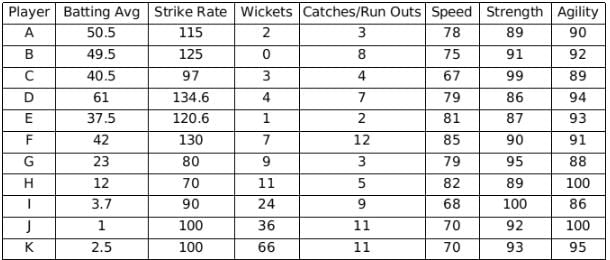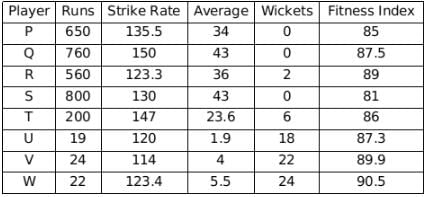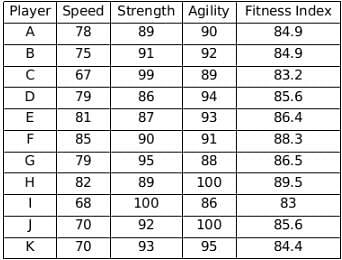CAT Exam > CAT Questions > The following table represents the records in...
Start Learning for Free
The following table represents the records in the last 5 series and fitness statistics of 11 Indian Cricket Team players A to K.

The Speed, Strength and Agility are measured in certain indices, and the values mentioned are out of a 0 to 100 scale. The Fitness Index is calculated as follows
Fitness Index = 0.4 x Speed + 0.3 x Strength + 0.3 x Agility
The following table represents the records in the last IPL season and the fitness index for 8 players, P to W, who have played in the IPL but are yet to debut for the Indian Cricket Team.

Based on the information, given above, answer the questions that follow.

The Speed, Strength and Agility are measured in certain indices, and the values mentioned are out of a 0 to 100 scale. The Fitness Index is calculated as follows
Fitness Index = 0.4 x Speed + 0.3 x Strength + 0.3 x Agility
The following table represents the records in the last IPL season and the fitness index for 8 players, P to W, who have played in the IPL but are yet to debut for the Indian Cricket Team.

Based on the information, given above, answer the questions that follow.
Q. Among the players who have played for the Indian Cricket Team, how many have a minimum fitness index of 85?
- a)6
- b)5
- c)7
- d)4
Correct answer is option 'A'. Can you explain this answer?
Most Upvoted Answer
The following table represents the records in the last 5 series and fi...
Since, the Fitness Index of A to K is calculated as follows,
Fitness Index = 0.4 x Speed + 0.3 x Strength + 0.3 x Agility, we get the fitness index of A = 0.4 x 78 + 0.3 x 89 + 0.3 x 90 = 84.9
Similarly calculating the fitness index of all the players from A to K,

Hence, the fitness index of D, E, F, G, H, and J are greater than or equal to 85.
Fitness Index = 0.4 x Speed + 0.3 x Strength + 0.3 x Agility, we get the fitness index of A = 0.4 x 78 + 0.3 x 89 + 0.3 x 90 = 84.9
Similarly calculating the fitness index of all the players from A to K,

Hence, the fitness index of D, E, F, G, H, and J are greater than or equal to 85.
Community Answer
The following table represents the records in the last 5 series and fi...
Since, the Fitness Index of A to K is calculated as follows,
Fitness Index = 0.4 x Speed + 0.3 x Strength + 0.3 x Agility, we get the fitness index of A = 0.4 x 78 + 0.3 x 89 + 0.3 x 90 = 84.9
Similarly calculating the fitness index of all the players from A to K,

Hence, the fitness index of D, E, F, G, H, and J are greater than or equal to 85.
Fitness Index = 0.4 x Speed + 0.3 x Strength + 0.3 x Agility, we get the fitness index of A = 0.4 x 78 + 0.3 x 89 + 0.3 x 90 = 84.9
Similarly calculating the fitness index of all the players from A to K,

Hence, the fitness index of D, E, F, G, H, and J are greater than or equal to 85.

|
Explore Courses for CAT exam
|

|
Similar CAT Doubts
The following table represents the records in the last 5 series and fitness statistics of 11 Indian Cricket Team players A to K.The Speed, Strength and Agility are measured in certain indices, and the values mentioned are out of a 0 to 100 scale. The Fitness Index is calculated as followsFitness Index = 0.4 x Speed + 0.3 x Strength + 0.3 x AgilityThe following table represents the records in the last IPL season and the fitness index for 8 players, P to W, who have played in the IPL but are yet to debut for the Indian Cricket Team.Based on the information, given above, answer the questions that follow.Q.Among the players who have played for the Indian Cricket Team, how many have a minimum fitness index of 85?a)6b)5c)7d)4Correct answer is option 'A'. Can you explain this answer?
Question Description
The following table represents the records in the last 5 series and fitness statistics of 11 Indian Cricket Team players A to K.The Speed, Strength and Agility are measured in certain indices, and the values mentioned are out of a 0 to 100 scale. The Fitness Index is calculated as followsFitness Index = 0.4 x Speed + 0.3 x Strength + 0.3 x AgilityThe following table represents the records in the last IPL season and the fitness index for 8 players, P to W, who have played in the IPL but are yet to debut for the Indian Cricket Team.Based on the information, given above, answer the questions that follow.Q.Among the players who have played for the Indian Cricket Team, how many have a minimum fitness index of 85?a)6b)5c)7d)4Correct answer is option 'A'. Can you explain this answer? for CAT 2025 is part of CAT preparation. The Question and answers have been prepared according to the CAT exam syllabus. Information about The following table represents the records in the last 5 series and fitness statistics of 11 Indian Cricket Team players A to K.The Speed, Strength and Agility are measured in certain indices, and the values mentioned are out of a 0 to 100 scale. The Fitness Index is calculated as followsFitness Index = 0.4 x Speed + 0.3 x Strength + 0.3 x AgilityThe following table represents the records in the last IPL season and the fitness index for 8 players, P to W, who have played in the IPL but are yet to debut for the Indian Cricket Team.Based on the information, given above, answer the questions that follow.Q.Among the players who have played for the Indian Cricket Team, how many have a minimum fitness index of 85?a)6b)5c)7d)4Correct answer is option 'A'. Can you explain this answer? covers all topics & solutions for CAT 2025 Exam. Find important definitions, questions, meanings, examples, exercises and tests below for The following table represents the records in the last 5 series and fitness statistics of 11 Indian Cricket Team players A to K.The Speed, Strength and Agility are measured in certain indices, and the values mentioned are out of a 0 to 100 scale. The Fitness Index is calculated as followsFitness Index = 0.4 x Speed + 0.3 x Strength + 0.3 x AgilityThe following table represents the records in the last IPL season and the fitness index for 8 players, P to W, who have played in the IPL but are yet to debut for the Indian Cricket Team.Based on the information, given above, answer the questions that follow.Q.Among the players who have played for the Indian Cricket Team, how many have a minimum fitness index of 85?a)6b)5c)7d)4Correct answer is option 'A'. Can you explain this answer?.
The following table represents the records in the last 5 series and fitness statistics of 11 Indian Cricket Team players A to K.The Speed, Strength and Agility are measured in certain indices, and the values mentioned are out of a 0 to 100 scale. The Fitness Index is calculated as followsFitness Index = 0.4 x Speed + 0.3 x Strength + 0.3 x AgilityThe following table represents the records in the last IPL season and the fitness index for 8 players, P to W, who have played in the IPL but are yet to debut for the Indian Cricket Team.Based on the information, given above, answer the questions that follow.Q.Among the players who have played for the Indian Cricket Team, how many have a minimum fitness index of 85?a)6b)5c)7d)4Correct answer is option 'A'. Can you explain this answer? for CAT 2025 is part of CAT preparation. The Question and answers have been prepared according to the CAT exam syllabus. Information about The following table represents the records in the last 5 series and fitness statistics of 11 Indian Cricket Team players A to K.The Speed, Strength and Agility are measured in certain indices, and the values mentioned are out of a 0 to 100 scale. The Fitness Index is calculated as followsFitness Index = 0.4 x Speed + 0.3 x Strength + 0.3 x AgilityThe following table represents the records in the last IPL season and the fitness index for 8 players, P to W, who have played in the IPL but are yet to debut for the Indian Cricket Team.Based on the information, given above, answer the questions that follow.Q.Among the players who have played for the Indian Cricket Team, how many have a minimum fitness index of 85?a)6b)5c)7d)4Correct answer is option 'A'. Can you explain this answer? covers all topics & solutions for CAT 2025 Exam. Find important definitions, questions, meanings, examples, exercises and tests below for The following table represents the records in the last 5 series and fitness statistics of 11 Indian Cricket Team players A to K.The Speed, Strength and Agility are measured in certain indices, and the values mentioned are out of a 0 to 100 scale. The Fitness Index is calculated as followsFitness Index = 0.4 x Speed + 0.3 x Strength + 0.3 x AgilityThe following table represents the records in the last IPL season and the fitness index for 8 players, P to W, who have played in the IPL but are yet to debut for the Indian Cricket Team.Based on the information, given above, answer the questions that follow.Q.Among the players who have played for the Indian Cricket Team, how many have a minimum fitness index of 85?a)6b)5c)7d)4Correct answer is option 'A'. Can you explain this answer?.
Solutions for The following table represents the records in the last 5 series and fitness statistics of 11 Indian Cricket Team players A to K.The Speed, Strength and Agility are measured in certain indices, and the values mentioned are out of a 0 to 100 scale. The Fitness Index is calculated as followsFitness Index = 0.4 x Speed + 0.3 x Strength + 0.3 x AgilityThe following table represents the records in the last IPL season and the fitness index for 8 players, P to W, who have played in the IPL but are yet to debut for the Indian Cricket Team.Based on the information, given above, answer the questions that follow.Q.Among the players who have played for the Indian Cricket Team, how many have a minimum fitness index of 85?a)6b)5c)7d)4Correct answer is option 'A'. Can you explain this answer? in English & in Hindi are available as part of our courses for CAT.
Download more important topics, notes, lectures and mock test series for CAT Exam by signing up for free.
Here you can find the meaning of The following table represents the records in the last 5 series and fitness statistics of 11 Indian Cricket Team players A to K.The Speed, Strength and Agility are measured in certain indices, and the values mentioned are out of a 0 to 100 scale. The Fitness Index is calculated as followsFitness Index = 0.4 x Speed + 0.3 x Strength + 0.3 x AgilityThe following table represents the records in the last IPL season and the fitness index for 8 players, P to W, who have played in the IPL but are yet to debut for the Indian Cricket Team.Based on the information, given above, answer the questions that follow.Q.Among the players who have played for the Indian Cricket Team, how many have a minimum fitness index of 85?a)6b)5c)7d)4Correct answer is option 'A'. Can you explain this answer? defined & explained in the simplest way possible. Besides giving the explanation of
The following table represents the records in the last 5 series and fitness statistics of 11 Indian Cricket Team players A to K.The Speed, Strength and Agility are measured in certain indices, and the values mentioned are out of a 0 to 100 scale. The Fitness Index is calculated as followsFitness Index = 0.4 x Speed + 0.3 x Strength + 0.3 x AgilityThe following table represents the records in the last IPL season and the fitness index for 8 players, P to W, who have played in the IPL but are yet to debut for the Indian Cricket Team.Based on the information, given above, answer the questions that follow.Q.Among the players who have played for the Indian Cricket Team, how many have a minimum fitness index of 85?a)6b)5c)7d)4Correct answer is option 'A'. Can you explain this answer?, a detailed solution for The following table represents the records in the last 5 series and fitness statistics of 11 Indian Cricket Team players A to K.The Speed, Strength and Agility are measured in certain indices, and the values mentioned are out of a 0 to 100 scale. The Fitness Index is calculated as followsFitness Index = 0.4 x Speed + 0.3 x Strength + 0.3 x AgilityThe following table represents the records in the last IPL season and the fitness index for 8 players, P to W, who have played in the IPL but are yet to debut for the Indian Cricket Team.Based on the information, given above, answer the questions that follow.Q.Among the players who have played for the Indian Cricket Team, how many have a minimum fitness index of 85?a)6b)5c)7d)4Correct answer is option 'A'. Can you explain this answer? has been provided alongside types of The following table represents the records in the last 5 series and fitness statistics of 11 Indian Cricket Team players A to K.The Speed, Strength and Agility are measured in certain indices, and the values mentioned are out of a 0 to 100 scale. The Fitness Index is calculated as followsFitness Index = 0.4 x Speed + 0.3 x Strength + 0.3 x AgilityThe following table represents the records in the last IPL season and the fitness index for 8 players, P to W, who have played in the IPL but are yet to debut for the Indian Cricket Team.Based on the information, given above, answer the questions that follow.Q.Among the players who have played for the Indian Cricket Team, how many have a minimum fitness index of 85?a)6b)5c)7d)4Correct answer is option 'A'. Can you explain this answer? theory, EduRev gives you an
ample number of questions to practice The following table represents the records in the last 5 series and fitness statistics of 11 Indian Cricket Team players A to K.The Speed, Strength and Agility are measured in certain indices, and the values mentioned are out of a 0 to 100 scale. The Fitness Index is calculated as followsFitness Index = 0.4 x Speed + 0.3 x Strength + 0.3 x AgilityThe following table represents the records in the last IPL season and the fitness index for 8 players, P to W, who have played in the IPL but are yet to debut for the Indian Cricket Team.Based on the information, given above, answer the questions that follow.Q.Among the players who have played for the Indian Cricket Team, how many have a minimum fitness index of 85?a)6b)5c)7d)4Correct answer is option 'A'. Can you explain this answer? tests, examples and also practice CAT tests.

|
Explore Courses for CAT exam
|

|
Signup for Free!
Signup to see your scores go up within 7 days! Learn & Practice with 1000+ FREE Notes, Videos & Tests.
























